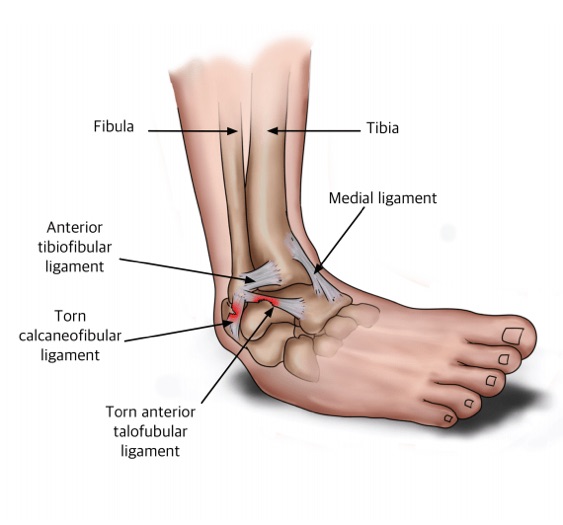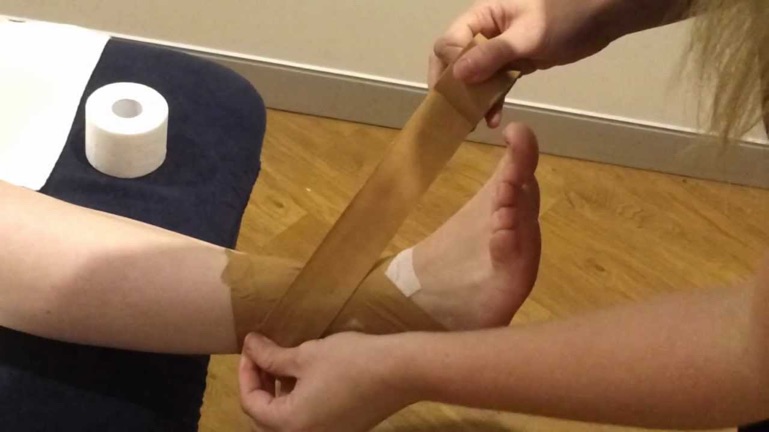Have you recently sustained a sprained ankle? Most of us have “rolled” or “sprained” our ankles at some point in time, whether this was during a sporting activity or simply while misplacing a step when walking. Some ankle sprains seem to resolve themselves overtime, whilst others take a few weeks to get back to normal. But have you ever felt ongoing pain with your ankle after your sprain? Have you sprained your ankle multiple times and not sure how to manage it?
How Sprained Ankles Occur
Ankle sprains are one of the most common lower limb injuries and can occur in sports that involve rapid changes of direction, especially if these take place on uneven ground e.g. grass fields. Ankle sprains can also occur when a player, having jumped, lands on another competitors feet. Sports such as basketball, volleyball, netball and football have the highest incidence rates.
The most common way that people sprain their ankle is when the ankle rolls outwards. This action can damage 2 ligaments in our ankle: the anterior talo-fibular ligament or ATFL, and the calcano-fibular ligament or CFL. These ligaments connect the bones in our foot to one of our lower leg bones, the fibula. When the ankle is rolled outwards, it is the ATFL that is most at risk of injury before the CFL, as the ATFL can only tolerate half the strain of the CFL before tearing.

When to suspect that you have a Sprained Ankle
- You may have heard or felt a loud snap, crack or tearing sensation
- You may see swelling, redness or bruising around your ankle
- Walking may be painful
- You may have pain with movements such as pointing the toes or turning the bottom of your foot inwards (inversion)
- It may be tender to touch the injured area
Note: If you are unable to place any weight on your foot, you may have in-fact broken a bone in your foot or ankle, and having your ankle x-rayed at your local hospital is suggested
What you can do to help your Sprained Ankle
Following the first few hours following your ankle sprain, you can follow the RICE technique:
REST– Rest the injured ankle from strenuous activity or sport as this can lead to further damage if a minor injury and increased swelling and pain in the area.
ICE– Ice the injury site, try to avoid applying ice directly to the area as this can lead to burning if left on for long periods of time. Ice the site for approximately 20 minutes at a time for the following 24-48 hours following the injury.
COMPRESSION– Try to compress the injured ankle as this will help manage the amount of swelling. You can do this by using a tight sock or a compression bandage commonly found in a first aid kit
ELEVATION– Elevate the injured ankle using a pillow or leg rest. Try to make sure the ankle is at a level higher than the heart. This will again help to reduce and manage swelling and pain.
There are some other important points to remember with ankle sprains. Now although we encourage rest from over-activity such as sport or running, it is important not to stay off your ankle completely, but try to move it slowly and gently within your pain tolerance; otherwise your ankle can stiffen up, interrupt much needed repair and increase recovery time. Following a solid amount of time icing and gently moving your ankle, the next step is to gradually increase your weight bearing. This may involve just small amounts of time on your feet, even just standing, trying to weight bear evenly through both of your legs and feet.
How to know when it is time to see a Professional for your Ankle Sprain
While a small ankle sprain may recover on its own quite well, if you suspect the sprain isn’t healing properly or fast enough, it is probably time to seek professional help, as there are potential long term complications for poorly managed ankle sprains including ankle instability, anterior or posterior impingement, chronic pain, or syndesmosis injuries.
A talented Physiotherapist, Osteopath or Chiropractor will be able to diagnose which ligament/s you have damaged, and put into place a treatment plan to:
- Strap or brace your ankle (if required) to reduce the load on the damaged tissues, and reduce your pain
- Provide hands-on treatment to relieve your tight or overactive muscles
- Directly treat your feet, ankles and knees to increase the mobility of you ankle joint and range of motion
- Strengthen the muscles around your ankle
- Teach you strategies and exercises to improve your balance
- Work with you to correct your posture and gait, and
- Provide specific rehab exercises to allow you to return to sport asap.
How your practitioner will achieve these things:
Range of Motion goals for a sprained ankle: In the early days of rehabilitation, it is important to restore your ankle mobility and movement in all directions. Your practitioner can help guide you through stretches and exercises to aid this, and can begin treatment using mobilisation techniques, which involves the practitioner manually moving the bones in your foot and ankle.
Muscle Strengthening and Proprioception for an ankle sprain: As soon as pain permits, your practitioner will begin to show you some muscle strengthening and proprioception exercises for your ankle. Proprioception is a fancy word that basically means awareness of where your body part is in space. Possessing adequate proprioception is vital to preventing re-injury.
Biomechanical Analysis for a sprained ankle: Your practitioner will assess you in terms of how you walk and weight bear, and this will help them determine if there is any underlying issues that need addressing e.g. flat arches or hip stabiliser weakness that will help in prevention of re-injury
Taping/Bracing for a sprained ankle: In returning to sport; studies have shown that ankle taping/ bracing can assist in reducing the likelihood of re-injuring your ankle. Taping will help to stabilise your ankle joint and support neuromuscular activity.
How long does treatment for an Ankle Sprain take?
Following an ankle sprain, relief can sometimes be felt immediately if load is taken off the damaged ligaments. Depending on severity of the injury, most patients will recover within 3-5 weeks if their recovery is being actively overseen by a professional.


